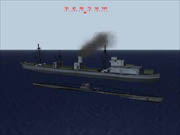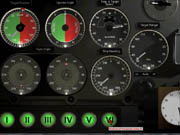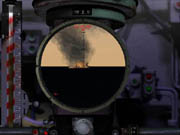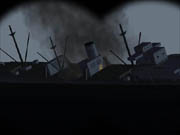The good news is that Silent Hunter II is the second best sub sim to come out this year. The bad news is that it's only the second sub sim to come out this year, Electronic Arts' Sub Command being the first. On the surface, it looks good and seems to get all the details right. But once you go a little deeper, you'll find the functional equivalent of screen doors on this sub sim. It's not quite all wet, but it's hardly in shipshape, either.

Silent Hunter II is set in the German U-boats of World War II, ranging from the coast of Norway all the way down to South America. This is rich subject matter for a simulation. German U-boats prowling the Atlantic were perhaps Germany's best chance to win World War II. Hitler almost succeeded in cutting Europe off from the United States' industrial and military might. Since both the Axis and Allies knew the stakes, the battle was fierce, prolonged, and expensive. Men, steel, and technology were poured into the Atlantic. In the end, Germany traded the lives of nearly 30,000 of her sailors to sink approximately 3,000 enemy merchant ships. This was a struggle of mythic proportion, captured beautifully in movies like Wolfgang Petersen's Das Boot, books like Herbert Werner's Iron Coffins, and games like Dynamix's Aces of the Deep, one of the finest sims ever.
This is also rich subject matter for a simulation because of the nature of the action. The pace is slow, deliberate, and tense. Submarine warfare is more about stealth than combat. You spend most of your time stalking your prey and waiting for the perfect chance to strike. You get one opportunity to land a blow, and from then on, you're the prey. From hunter to hunted in the launch of a torpedo.
On both counts, as a nod to that period of history and that style of warfare, Silent Hunter II does a decent job. The single-player campaign tries to capture the epic nature of the U-boat struggle by following the flow and ebb of Germany's fortune through the course of the war. Rather than playing like a traditional career mode, Silent Hunter II is more of a globe-trotting showcase for the U-boat's greatest hits. You start out heading off the fleeing Polish navy, then you dabble in the Atlantic, then you join the invasion of Norway, then it's a brief jaunt into the Mediterranean (with the obligatory "slip through Gibraltar" mission), then to the East Coast of the United States and down to the Bahamas, and so on, all the way to Buenos Aires at the end of the war. The campaign begins in the submarine's halcyon days with coordinated wolf pack attacks and frequent reports from Luftwaffe reconnaissance planes. As the war progresses, you get a good sense for the developing technology, Germany's increasing desperation, and the Allied dominance of the seas with their ubiquitous destroyer escorts and air cover. Silent Hunter II takes you through the rise and fall of the Third Reich, as seen through a periscope.

While this is an interesting concept, the developers at Ultimation sacrifice any long-term replayability by building Silent Hunter II almost entirely around this historical story arc. Each mission is tightly scripted and offers almost zero chance for freedom or exploration, which means there's very little replay value. Not that you won't be replaying missions, because Silent Hunter II's campaign is a strictly linear affair. Each mission must be completed before you can move on to the next. If you fail the mission's primary objective, you get to replay it--only this time you'll know exactly what to expect, as well as when and where to expect it. Unlike in Sub Command's missions, there's very little randomness in Silent Hunter II. The tension of uncertainty is replaced by the tedium of repetition.
This will also impact the way you play the game. For instance, take the realism setting for dud torpedoes. Torpedoes that failed to go off when they struck their targets were a very real problem in World War II, particularly early in the war. Sometimes subs would return from a patrol with a 100-percent dud rate. But the commander didn't have to go back out and fire over and over at the same ship until he got a live torpedo, because failure was a part of submarine warfare. It is not, however, a part of this sim, which demands you go back and do it over. And over. And over. Who wants to contend with dud torpedoes when you're dealing with a primary goal that must be achieved to unlock the next mission? War might be hell, but Silent Hunter II is the frustration of often having to replay the same mission.
There are eight stand-alone missions, and you can set up single encounters by specifying the exact parameters of how many ships, whether they're escorted, where they start, and so on. There won't be any surprises in these encounters, which are little more than training tools. And because the stand-alone missions and single encounters play out in a vacuum (your score isn't even tracked), they don't have the incentive and higher stakes of the full campaign. There is no scenario generator, so don't expect downloadable third-party scenarios on the Internet. During the development process, Ultimation repeatedly assured concerned fans that Silent Hunter II wouldn't suffer for its lack of a dynamic campaign. On the contrary, what they've created is a pale shadow of the game it could have been. It's worth mentioning that Ultimation does promise multiplayer interconnectivity when it releases Destroyer Command, which might give Silent Hunter II a bit more longevity.

There's no denying that Ultimation did capture the basic dynamics of submarine warfare. It's gratifying to strike at a convoy, creep away before the torpedoes strike, and then listen while the destroyers drop depth charges far away, obviously looking for you in all the wrong places. The missions are generally long enough to duplicate the feel of being away at sea. Although you're usually dropped near your objective area when a mission starts (with your fuel tanks mysteriously topped off), you have to work your way home after a mission. Later in the war, this involves creeping by day and dashing ahead at full speed by night to escape bomber attacks.
If you're looking for realism in your sims (what history buff isn't?), then you're going to be disappointed by some of Ultimation's choices. All ships are automatically identified well before you come into firing range, so there's no danger of inadvertently sinking friendly or neutral ships. When a ship is tagged by the game as having been destroyed, you can't designate it as a target. Even though it might still be afloat and slowly going through its sinking animation, you know it's already dead. In World War II, this wasn't always so easy to determine, and many ships limped away and lived to tell about torpedo attacks. This often meant multiple coups de grace were administered by sub commanders, but Silent Hunter II makes no provision for this. Although there's a good damage system to track attacks and breakdowns on your sub, many missions end suddenly without putting the player through those final frantic moments of trying to bring a dying sub to the surface. Instead of that sinking feeling of dread as the dial on the meter sweeps past your crush depth, Silent Hunter II snaps you to an outside view and then pops up the debriefing screen. Perhaps worst of all is the atrocious ship artificial intelligence, in which destroyers won't help each other out while chasing you down. Perhaps this is because when they do work together, they're liable to ram into each other and get stuck. We've even seen ships so dumb they've rammed entire continents, washing themselves up on shore and keeling over like beached whales.

The graphics are limited to 800x600 resolution, but they're not as fancy as you might expect with all the processing power freed up by the lower resolution. This is definitely a sim that's been in development so long it's given up all hope of showing off on higher-end systems. Waves roll and ships pitch convincingly, but there's a noticeable lack of embellishment like land features, deck activity, white caps, weather effects, and dynamic lighting. Smoke effects, splashes, and explosions look as if they were tacked on. The sound, which is a crucial element of a sub game, is generally very good, featuring groaning hulls, bass explosions, water flooding through hull breaches, and the ominous churn of screws.
Since the pickings are indeed slim for naval simulations, Silent Hunter II will be a welcome addition for a lot of fans. But without a more involving campaign mode, with these glaring gaps in realism, and with this lackluster graphics engine, a lot of these fans are bound to be disappointed. Perhaps with the release of Destroyer Command later this year, more of Silent Hunter II's potential will be realized. But as it is now, this is a sim nearly scuttled by a few bad choices.